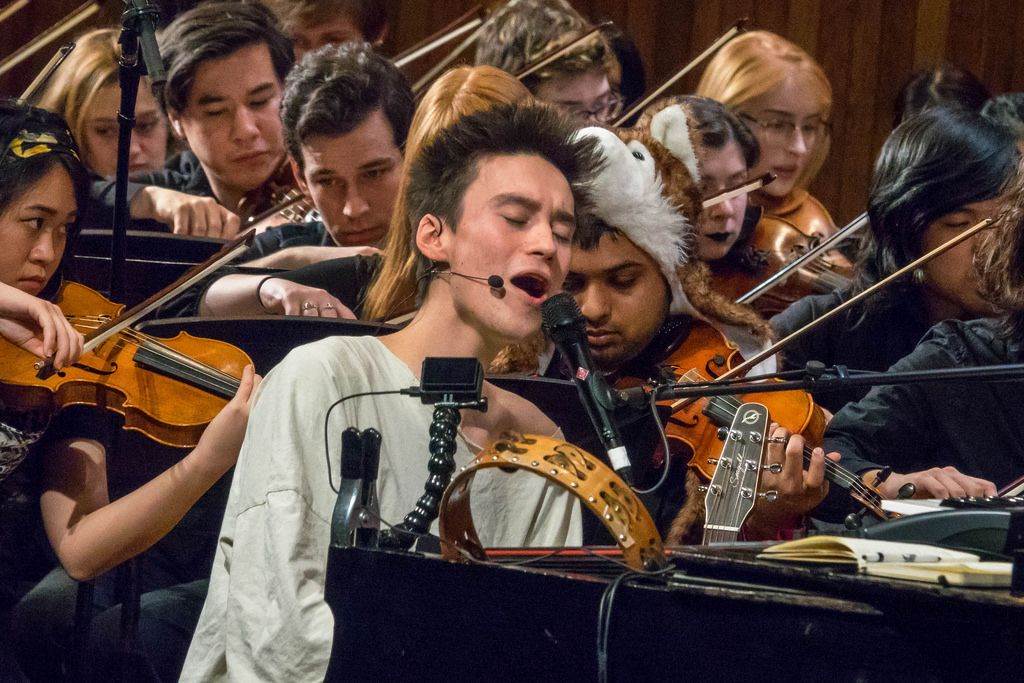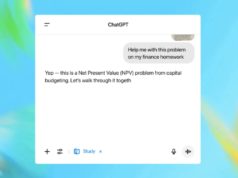
A productive artist residency generally provides the yin to an artist’s yang. If daily life is distracting, for example, an artist may relish solitude. If, on the other hand, the artist is Jacob Collier, a self-contained singer-songwriter-performer-composer-arranger-producer who mostly works alone in his family’s London home music room, then collaborating with over 150 eager students may present a welcome change. Collier, the immensely talented 22-year-old multi-instrumentalist, known for his complex YouTube videos, his live multi-track one-man shows, his celebrated debut album, “In My Room,” and his two 2017 Grammy awards for his arrangements of “You and I” and “Flintstones,” was in residence at MIT in fall 2016.
Fred Harris, MIT lecturer in music and director of the Institutes’ wind and jazz ensembles who conceived and spearheaded the residency, says, “With few exceptions, Jacob’s been rather isolated in his musical creativity, yet he yearns to collaborate.” Through the MIT Center For Art, Science and Technology’s Visiting Artists Program, Harris invited Collier to work with the MIT Festival Jazz Ensemble; Ben Bloomberg, a PhD student in the Media Lab in the Opera of the Future group; Jamshied Sharifi ’83, composer, producer and keyboardist; and a specially assembled orchestra and chorus comprised of music students from MIT, Berklee College of Music, New England Conservatory, University of New Hampshire, and Boston Arts Academy. At the culminating concert, “Imagination Off the Charts,” Collier said MIT feels like “a second home” to him:
“I’ve always felt a kinship with this idea of celebrating the introvert. I’ve learned the skills of being an extrovert, when I go on tour and when I perform. There’s lots of joy that is found by giving, but I think at MIT, there’s a sublime understanding of the people who think inwards first. And I would count myself amongst that group of people. So I’d like to celebrate that idea; being at MIT consistently reminds me of how wonderful it is when people think beyond the surface level, up and down to other realms of things. I’d like to say thank you to MIT as a concept, and additionally to the human beings with whom I’ve been working at MIT.”
The concert featured works by Collier, newly arranged for the jazz ensemble and full orchestra by Collier himself and by Sharifi, as well as a new improvisational piece, “Sonic Bloom Mountain,” reliant on an app created by Bloomberg and Peter Torpey. With its jubilant performances from scores of vocalists and orchestra members and the singularly talented Collier, all playing to a rapt and packed audience, the concert was one measure of the residency’s success. But, as Harris points out, the behind-the-scenes activities — the months of thoughtful planning, engaging rehearsals, arduous transcription work and technical invention — are what make the residency meaningful to the students and the artist alike: “Obviously the crux of the project is not just bringing Jacob to MIT. Any place could bring Jacob to perform. It’s what we’re doing with him with our students and how our students are interacting with him in ways that no one else has yet. This is the first ever college residency he’s done. So I’m trying to set the bar pretty high.”
The relationship begins
Collier’s introduction to MIT began with a Facebook message from Ben Bloomberg in 2014. Bloomberg, who specializes in the design and implementation of advanced surround sound and other live performance systems, wrote to compliment his work and to offer his assistance with future technical needs. “It was perfect timing,” he recalls, “because Jacob had just been asked to do this massive performance in front of 4,000 people at the Montreux Jazz Festival, and he didn’t know what he was going to do. He had all these crazy ideas involving technology. It was just luck that I sent him a message that same week. He responded, essentially like, ‘Oh, yeah, we need that.’ One of the things that I really get excited about is trying to figure out how to design these systems so that they stand up to the test of a live show.” Since then, Bloomberg has developed scalable performance systems and customized instruments, such as a 12-note vocal harmonizer, for Collier to transform his video productions into live one-man concerts.
When Harris learned of Bloomberg’s friendship and prior work with Collier, he “immediately saw a door open.” He invited Collier to MIT in fall 2015 to work with the Festival Jazz Ensemble in a free-form master class.
“What I realized is that as amazing as his music videos are … they are the tip of the iceberg,” Harris says. “The range of his musical interests and the depth and breadth of his talents are incredible. One could look at those videos and pigeonhole him, but they would be making a big mistake, because his range goes from Renaissance music to contemporary classical music, jazz, and pop. In that master class, he was doing all kinds of things ranging from playing jazz piano with us and playing with the big band to dissecting one of his music videos… . By the end of the class, we got inside one of Jacob’s greatest gifts, creating harmonies. He had all of the members of the jazz ensemble — like 20 people who are not vocalists — singing complicated chords, really dense 20-part chords. He’s the full package as a musician.”
“Imagination off the charts”
Harris says, “What I wanted to do with this residency is give Jacob a musical playground. I wanted to say, ‘I am blown away by what you represent. I’m going to give you a bunch of toys and see how you’re going to play with them, because it’s going to be great for our students.’ What I try to do in residencies is give artists something that will excite them.”
During the residency, Bloomberg and Torpey worked with Collier to create a new app that allowed him to use iPads and midi controllers to play the Festival Jazz Ensemble like the harmonizer. For the resulting improvisational piece, “Sonic Bloom Mountain,” named after Bloomberg, the jazz ensemble reacted in real time to notes Collier sent to their mobile devices.
MIT senior Garrett Parrish, a Festival Jazz Ensemble drummer who rehearsed and performed with Collier and has worked in the Media Lab with Bloomberg, says, “From a performance perspective, the system allows for Jacob to, in the moment, transmit his musical ideas to tens of people. It’s every musician’s dream to be able to wave your arms and have a band know exactly what to play and how to play it without having to tell them, and that’s what we did with this piece [‘Sonic Bloom Mountain’]. I’m sure it was a god-like experience for him as much as it was a collectively thrilling experience for the band.” He adds, “Creating meaningful technological enhancements for human performance is incredibly difficult,” but it can work seamlessly on rare occasions, “when you have the union of Jacob and Ben, both of whom are equally creative, imaginative, and skilled — granted, at different things.”
Harris devised another way for students to tap into Collier’s diverse talent. He asked MIT alumnus Jamshied Sharafi to transcribe and arrange three songs from Collier’s 2016 album “In My Room,” — “Hideaway,” “Down the Line,” and “Saviour” — for jazz ensemble, chorus, and full orchestra. Translating these solo pieces was no easy task, given Collier typically plays all 30 to 50 parts himself and rarely writes down the music. Sharifi’s transcriptions aimed to honor what Collier did on his recordings, while leaving room for spontaneity. Collier also wrote a new arrangement of his song “Hajanga,” a personal favorite, for the Festival Jazz Ensemble and string orchestra. Collier’s own orchestral arrangement of “In the Very Early Morning,” a beautiful piece recently performed in London’s Royal Albert Hall, and several jazz and pop standards rounded out the program.
Harris was consciously creating a once-in-a-lifetime experience for students, while hopefully commencing an enduring relationship with Collier. “It’s so rare to be able to come in contact with a musician at such an early stage of his career, you know? There’s no question in my mind that whatever he ends up doing in the next 50 or 60 years, it will be amazing. So the fact that we can have this relationship early on — which I hope continues — is very magical.”
Performing with Collier made a strong impression on students like Parrish. “Jacob gives off such a humble, supportive, yet inimitable talented aura that brings everyone up with him, rather than outshining them by comparison. That is the key,” says Parris. “He helped me play better, brought out parts of me I didn’t remember or know existed, and I think that can be said for everyone. The difference between Jacob and almost any other performer I have worked with is that his intention is so deeply thought-out and real. When it comes to music, the intention behind it is what makes it sing, and, man that boy can sing.”
Harris has been bringing in guest artists to work with his students regularly since 2000. Sometimes, he says, it involves musicians playing with the Wind Ensemble and Festival Jazz Ensemble on an existing piece; often it involves musicians composing music expressly for the students; and in the case of Collier, it was a combination of both. “My feeling is, is that the students at MIT gain a world class education. They have contact with the greatest faculty members and outside practitioners in all the disciplines — in engineering and political science, in whatever subject. It should be and is the same thing in the arts. And not just someone who comes in and gives a talk. I mean, real substantial contact, where there are legs to the project, where we form relationships. … I’m already dreaming about what…







